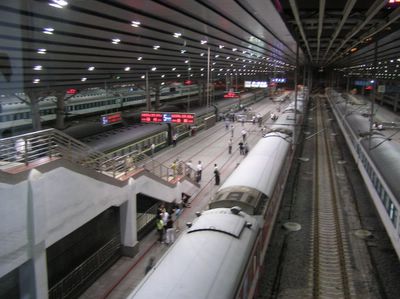(Note: this post was originally written on September 23, 7 days after our return)
China…intriguing history, welcoming people, crowded cities, incredible scenery. We are home and settling back into our everyday lives, changed (as we always are) by our experiences in a different culture. Early exhaustion and early waking are still part of our daily routine, a part we hope will be resolved soon.
We left the US on September 1 but our journey began in earnest when we landed in Beijing on September 2. We stayed in Beijing for 3 days and caught all the popular sites. Traveling on to Xi’an by overnight train, we explored the city for 2 days visiting the Terracotta Soldiers, the old city wall, the Moslem Quarter and many other sites.
After an evening flight to Guilin, the morning of day 5 found us floating down the Li River to Yangshuo, experiencing our first glimpses of the famous limestone mountains. We spent several days in Yangshuo bicycling in the countryside, hiking to Moon Hill, winding our way through the Silver Cave, exploring night markets, walking through rice paddies and eating at local eateries. Our time here was too short!
Late Sunday evening, after driving back to Guilin and flying to Chongqing, we were rushed aboard the President Cruise Ship #4 for a 2.5 day cruise on the Yangtze River. This was the most relaxing leg of the journey. John and I spent our first cruise day sitting on our balcony, watching the ever changing shore, reading and sleeping. We sailed through the Three Gorges on day 2 of the cruise and saw the massive concrete structure called the Three Gorges Dam in the morning of day 3.
With the cruise complete, we hopped in a van and for 4.5 hours we drove as the changing Chinese countryside flew past our windows. Our destination…Wuhan, for dinner, a night’s sleep and a morning flight to Hong Kong. Hong Kong, our final stop before returning home! We were ready for this exciting, easy to navigate, very westernized city. That we could explore without a translator was a bonus.
Below are a few pictures from our time in Beijing and Xi’an.
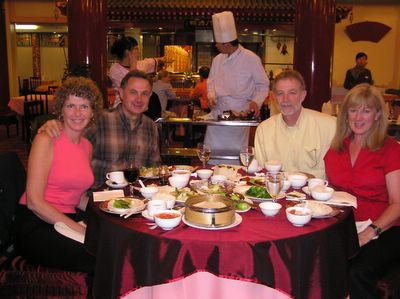
Our first taste of Peking Duck
Peking Duck was the main course (for 3 of us) for our first dinner in Beijing. Peking Duck is usually served in 3 courses but we had mostly the 2nd course (duck meat), with some of the 1 st course (crispy skin). Peking duck is served with mu-shi flour pancakes (wafer thin), slivered green onions and plum sauce. The duck meat is dipped in plum sauce, placed on the pancake with several onion slivers and rolled in the pancake. Yummy!
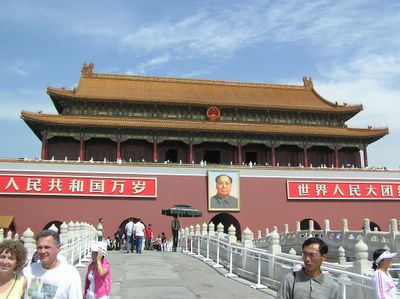
The Forbidden City
Built between 1406-1420, the Forbidden City served as the residence for emperors of the Ming and Qing dynasty. The FC is divided into 2 major sections, the outer palace for business and inner residential buildings. Because we had a lot to see, we buzzed through the Forbidden City in a couple of hours, we could have spent days. Above, Chairman Mao glares out at Tiananmen Square from his perch on the outer walls at the Forbidden City.
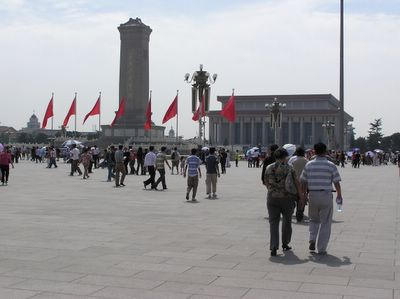
Tiananmen Square (Gate of Heavenly Peace), nuff said.
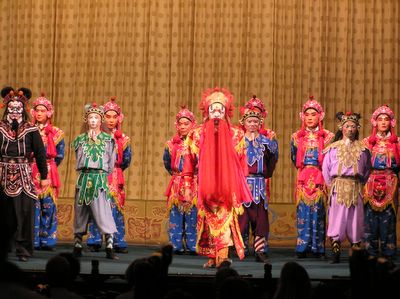
The cast of the Beijing Opera
We spent an evening at the Beijing Opera during our stay in the city. It depends on whether you are me or Will, Kim and John as to whether the experience was enjoyed or not. Unfortunately, we were all exhausted and struggled to stay awake. The next morning our guide told us that China’s youth do not like the opera and are very grateful for the tourists that keep this bit of tradition alive.
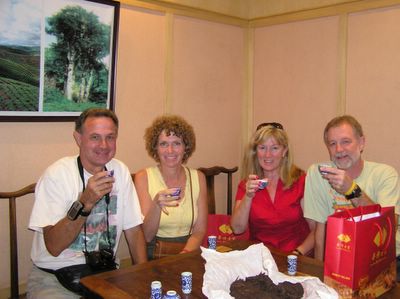
The fine art of drinking tea
On our last day in Beijing, we stopped at Mr. T’s Teahouse for a delightful demonstration on how to make and drink Chinese tea. Note in the photo above, the men are holding the teacup with their middle finger on the foot of the cup to stabilize it, fourth and pinkie fingers curled under…very manly. The women, on the other hand, have their fourth and pinkie fingers thrust outward. I think we forgot these rules with our next cup of tea. And yes, we each brought home a little bit of Chinese tea to enjoy.
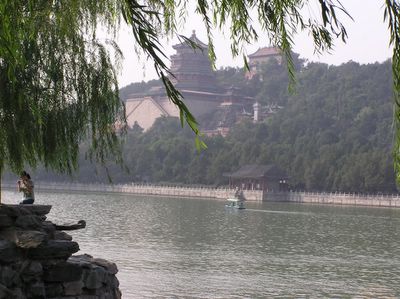
Summer Palace (Garden of Cultivating Peace)
Originally built in the 12 century, this 717-acre garden provided us with a relaxing afternoon stroll and dragon boat ride from shore to shore. Another place itching for further exploration but we just didn’t have time.
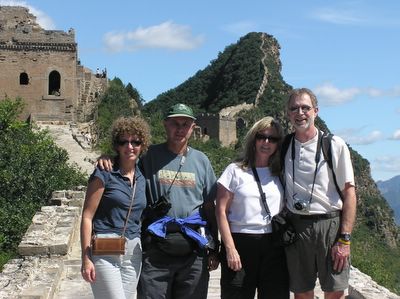
The Great Wall in Simatai (also known as the “Wild Wall”)
One of our most memorable experiences was our trip to the Simatai section of the Great Wall. This section seems to hang precariously on the Yanshan Mountains.
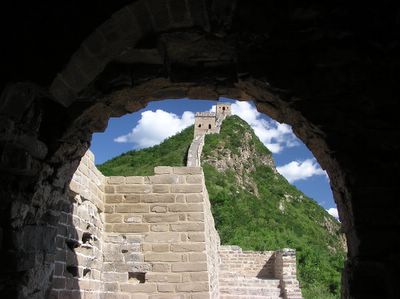
The Great Wall photographed through one of the watch towers
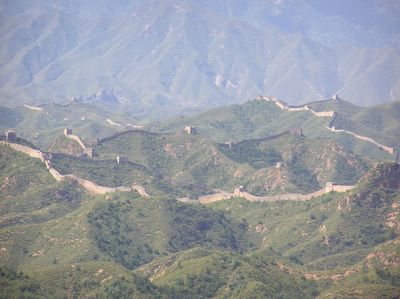
The Great Wall is truly great
The Beijing train station is unlike anything I could have possibly imagined. Hundreds of people poured through a single front door and lined up at the security checkpoint to toss their luggage on a single conveyer belt. The luggage passed through an x-ray machine (in disorganized mass) and spilled out the other side. People (mostly Chinese) were crammed along the belt to claim their bags. I couldn’t get close to my bag so I took a chance and literally jumped into the crowd, eventually surfacing with my bag. Whew! Jill, our guide, ushered us and our baggage to the correct platform and said goodbye. Soon we were off into the darkness alone, crammed into our little soft sleeper, looking forward to our next stop, Xi’an.
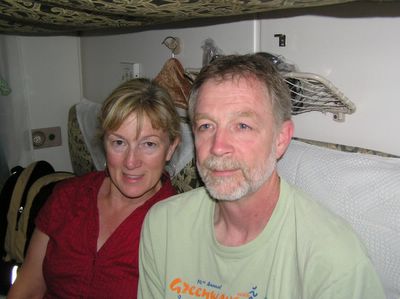
Exhausted tourists!
Do we look tired or what? Our train departed at 8:30 pm and we couldn’t wait to go to sleep! The 4 of us shared a soft sleeper compartment (basically 4 bunk beds equipped with hard mattresses and silk comforters). John and I claimed the top bunks and Will and Kim the lower. Stowing our luggage above the compartment door was an interesting contortion act performed by John and Will. The act included lifting heavy luggage while hanging from bars around the door. Overnight train travel is an experience not to be forgotten!
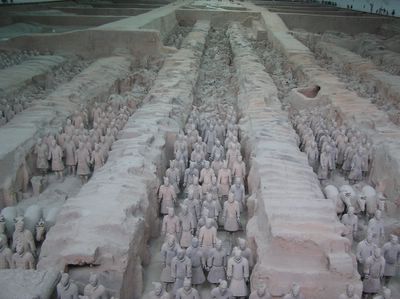
Terracotta Soldiers
Our main reason for traveling to Xi’an (pronounced Ci’an), the Terracotta Soldiers. Surely the most spectacular site in China, these soldiers were buried some 2,200 years ago to protect the tomb of the first Qin emperor. The emperor left no record of the army’s existence and remained a speculation until the sight was discovered in 1976 by a couple of farmers searching for water during a drought.
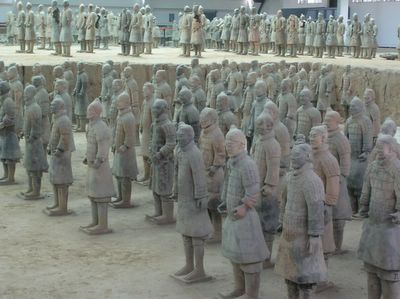
The soldiers of Vault Number One face east toward the emperor’s tomb
Soldiers are lined up about 70 across, 150 deep and are separated by 10 walls and 11 corridors. The next 2 vaults are smaller but no less interesting. The soldiers on the wall in the above photo are in various stages restoration. Visible dark blotches indicate missing sections . Archaeologists will replicate only small pieces, large pieces not recovered are left unrepaired.
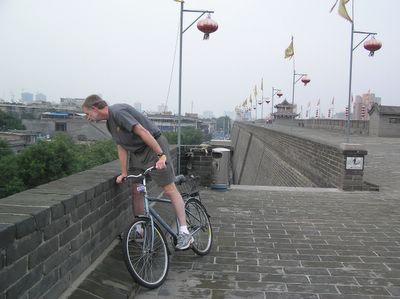
Xi’an City Wall (built from 1374-1378) “It’s a long way down!”
We explored the great city wall around of Xi’an by bicycle. Unfortunately the south gate was under repair and we were pushing the closing time for the bicycle rental stand so we had only 40 minutes to ride and marvel at the construction. The red lanterns along the wall are magical when lit at night.
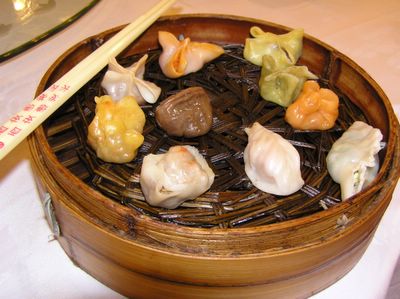
DeFachang’s Dumpling Banquet
One of our favorite meals on the trip was the dumpling dinner at DeFachang in Xi’an. Fish, meat and vegetable dumplings were served along with a nut dumpling (brown dumpling). 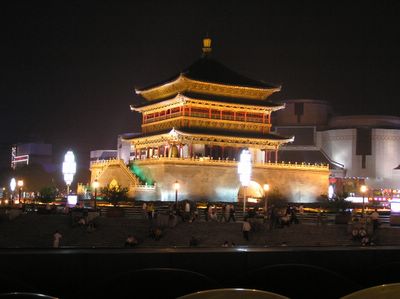
Bell Tower (Zhong Lou)
The Bell Tower was built in the Ming dynasty in 1384 and moved to it’s current location in the city center 200 years later (note the bell on the front left corner). Even though we did not have an opportunity to tour the tower, the building served as landmark for us when finding our location within the city.
